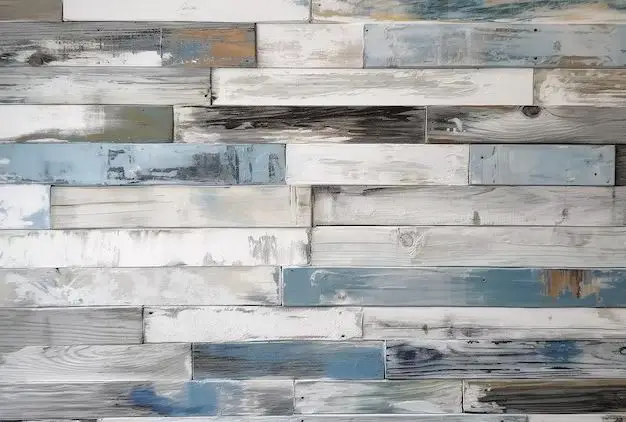Peel and stick wallpaper, also known as self-adhesive wallpaper or removable wallpaper, has become an increasingly popular option for easy DIY home decor over the past few years. Unlike traditional wallpaper that requires messy paste and patience to hang, peel and stick wallpaper can be easily applied to many surfaces with just a few strips. This makes it an ideal temporary solution for renters or homeowners looking to quickly spruce up a space without a major commitment. But can it be used on more than just drywall? Specifically, can peel and stick wallpaper go on wood surfaces like paneling, cabinets, and furniture? Let’s take a closer look at how removable wallpaper works and what you need to know before applying it to wood.
Page Contents
How Peel and Stick Wallpaper Works
Peel and stick wallpaper has a backing layer that is coated with a water-activated adhesive. The adhesive allows the wallpaper to bond to smooth surfaces when pressure is applied. The top layer is then a decorative film layer that provides the pattern or texture. This thin material is flexible and designed to remove cleanly later on without damaging the surface underneath.
Here is a breakdown of how traditional and peel and stick wallpaper work:
Traditional Wallpaper
- Applied using wallpaper paste to adhere it to the wall
- Removes with water and scraping to lift off paste
- Can damage drywall when removing
- Labor intensive to hang with precise alignment
Peel and Stick Wallpaper
- Applied using built-in adhesive activated by water
- Removes by peeling off gently with no mess or damage
- Alignment and hanging is easy with instant bond
- Reusable if removed carefully from original backing
As you can see, peel and stick wallpaper is designed to avoid many of the headaches of traditional wallpaper. The key benefit is that it can be removed or repositioned multiple times without ruining the surface underneath. This makes it ideal for temporary updates. But how does this work on more delicate surfaces beyond drywall?
Using Peel and Stick Wallpaper on Wood
Peel and stick wallpaper can technically be applied to many different surfaces beyond regular drywall, including wood paneling, furniture, cabinets, and more. However, there are some special considerations to keep in mind before using it on wood.
The Advantages
Here are some of the benefits of using peel and stick wallpaper on wood:
- Adds style easily to dated, dull wood paneling
- Can temporarily change the look of cabinets or furniture
- Repositionable so you can modify the layout
- Much simpler than painting or sanding wood
- Prevents permanent damage like nicks or nail holes
If you want to update wood surfaces without the commitment of painting or sanding, peel and stick wallpaper provides an easy refresh.
The Disadvantages
However, there are also some downsides to keep in mind when using removable wallpaper on wood:
- Wood paneling or furniture may not have smooth, consistent surfaces for the wallpaper to adhere to
- Old, porous, or textured wood may allow air bubbles to appear more easily
- Moisture from the adhesive could damage or warp delicate wood over time
- Removal risks peeling away wood finish or veneer if not done carefully
The textured and absorbent nature of wood surfaces means the wallpaper may not bond as evenly compared to flat, painted drywall. The moisture introduced during application can also impact more delicate wood over time.
Best Practices for Applying to Wood
If you do want to use peel and stick wallpaper on a wood surface, here are some tips to get the best results:
- Clean the surface thoroughly and sand down any extremely uneven areas
- Prime and paint the wood with 1-2 base coats first to create a uniform surface
- Avoid heavily textured wood like cedar or rough-cut lumber
- Use low moisture adhesive wallpaper suitable for wood
- Roll surface firmly with smoothing tool to prevent bubbling
- Take care peeling off slowly at 180 degree angle to protect wood
Proper surface prep and using low-moisture wallpaper suited for wood will provide much better adhesion. Peeling the wallpaper off carefully straight out, rather than upwards, also helps avoid pulling off splinters of wood when removing.
Here is a comparison of how standard peel and stick wallpaper versus wood-suitable wallpaper are applied:
| Standard Wallpaper | Wood-Suitable Wallpaper |
|---|---|
| – Higher moisture adhesive | – Low moisture adhesive |
| – Applied directly to raw wood | – Used on primed or painted wood |
| – Prone to bubbling on textured areas | – Smoother finish with less bubbling |
| – Risk of wood damage when removing | – Reduces chances of wood damage upon removal |
Conclusion
Peel and stick wallpaper can technically be applied to wood surfaces like paneling, furniture, and cabinets. However, the absorbent and uneven nature of raw wood means you may get better results if you properly prepare with priming and painting first. There are also wallpapers made specifically for wood that reduce moisture and adhesion levels to prevent issues. With the proper prep and product, peel and stick wallpaper can allow you to easily update and customize wood surfaces for a temporary decorative change. Just take care when removing it slowly and at the right angle to avoid any veneer or finish from lifting up.
